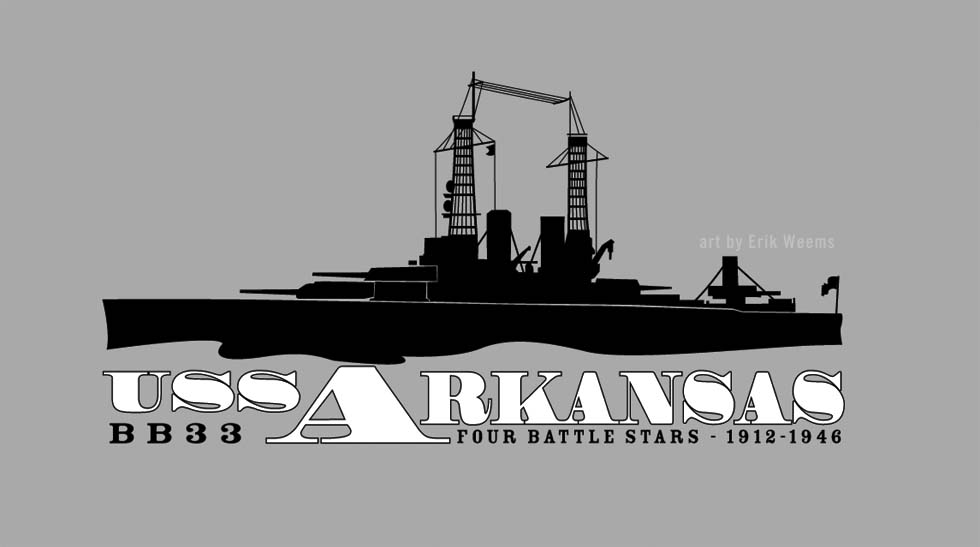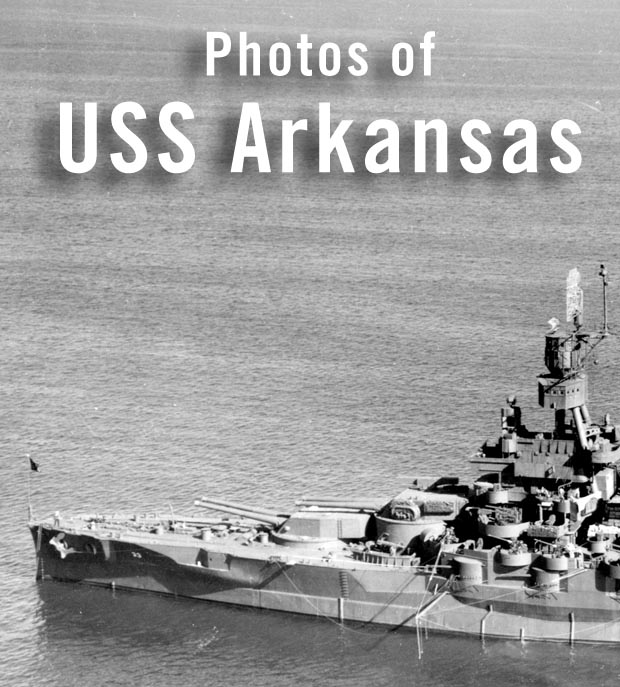Bio History of the "the Arky" - USS Arkansas
The 3rd U.S. Navy Ship to be named after the 25th state
History
The battleship USS Arkansas was the third ship of the United States Navy to bear the name of the 25th state. The construction of the vessel was authorized by the United States Congress on March 3, 1909, and the keel laid January 10, 1910 by the New York Shipbuilding Corporation in Camden, New Jersey. The Arkansas was launched January 14, 1911, and commissioned at the Philadelphia Navy Yard on September 17, 1912, with Captain Roy C. Smith in command.
In December, 1912, the USS Arkansas transported President William Howard Taft to the Panama Canal Zone, then departed for crew training and ship shakedown, returning to ferry Pres. Taft to Key West, Florida. The Arkansas then joined the US Atlantic fleet and participated in a Mediterranean tour in 1913.
The commissioning of the USS Arkansas was indirectly responsible for the creation of the official state flag of of Arkansas, in which the Pine Bluff chapter of the Daughters of the American Revolution sponsored a contest for designs, the winning version presented in 1913 to the officers and men of the Arkansas.
In April 1914, the Arkansas was ordered to Veracruz, Mexico, by President Woodrow Wilson to participate in the military conflict there and to provide protection for US citizens under threat following the ascension to power of the Mexican dictator Victoriano Huerta. The Arkansas put ashore 330 men in four companies who participated in street fighting, with two casualties and two Arkansas' officers later awarded Medals of Honor for their actions.
In October the Arkansas returned to the US naval station at Hampton Roads, Virginia, where the ship remained for four years of patrol duties along the East Coast and the Caribbean.
When the United States entered World War I on April 6, 1917, the Arkansas was attached to US Battleship Division Seven. In July 1918 the Arkansas was sent to Scotland to support the British Navy, becoming a part of the British Grand Fleet, assigned to the Sixth Battle Squadron. The Arkansas was among the ships present at the internment of the German High Seas Fleet in the Firth of Forth on November 21, 1918.
Following the armistice that ended the war, the Arkansas performed escort duties for Pres. Wilson's visit to Brest, France, and from there was sent to New York City, and then to the Norfolk, Virginia navy yard for repairs. In July 1919 the Arkansas was assigned to the US Pacific fleet, and sailed for San Francisco, California.
Following an earthquake in Santa Barbara, California, in June 1925, the Arkansas put medical corpsman and military patrols ashore to assist in recovery efforts there. During these peacetime years until the Japanese attack on Pearl Harbor in 1941, the Arkansas served primarily as a patrol and exercise training ship, receiving regular modernization upgrades and tours that included the West Coast, Hawaii, Canada, the Caribbean, and Europe.
Following the outbreak of World War II, the Arkansas participated in regular convoy escort duties, frequently crossing the Atlantic to Europe and North Africa.
During the D-Day invasion at Omaha Beach on June 6, 1944, the Arkansas covered the landings from 4,000 yards off shore, fighting with German shore batteries and undergoing attacks by aircraft. On June 25th, the Arkansas repeated bombardment duties against German artillery at Cherbourg, France. By this time the USS Arkansas was the oldest Battleship in active combat duty in the United States Navy.
The Arkansas then moved to the Mediterranean, and on August 14th participated in Operation Anvil, the invasion of the southern French coast between Toulon and Cannes, providing fire support for two days. From there the Arkansas traveled to the United States for repair and rest. In November, 1944, the Arkansas moved to San Diego, California, for preparations for attacks on Japanese strongholds in the Pacific Ocean.
On February 16th, 1945, the Arkansas began bombardment on the Japanese held island of Iwo Jima. She continued fire through the 19th. The Arkansas then moved off to the Ulithi atoll in the Caroline Islands for rearming and provisions. She was at the Japanese island of Okinawa on March 25th, where she performed 46 days of bombardment work while fighting off numerous kamikaze attack.
At the war's end, the Arkansas participated in "Magic Carpet," the program to get US military men back to the United States as quickly as possible. The Arkansas made trips from Nakagusuku Bay and Hawaii, carrying thousands of soldiers.
In January 1946, the Arkansas was stationed to San Francisco, California. Because of her age, the Arkansas was selected for the atomic bomb tests at Bikini Atoll in the Marshall Islands for the purpose of observing nuclear effects on naval craft. Along with an assortment of other aged ships and captured Japanese vessels, the Arkansas was subjected to the airborne atomic explosion of "Test Able" on July 1, which she survived. The "Arky" sank on July 25, 1946, during the second nuclear test, called "Baker" which was a submerged detonation from 90 feet below the water surface. The Arkansas now rests upside down in 170 feet of water in the Bikini Atoll lagoon, where it is often inspected by recreational deep sea divers.
The USS Arkansas received four battle stars for her World War II service.
Technical Summary
The USS Arkansas was designed for a crew of 1,594 sailors. Equipped with twelve 12" 50 caliber guns with a 16,000 yard range. She measured 562 feet in length, and 93 feet wide. Originally equipped with coal-burning boilers, these were replaced with oil-burning in 1925. The Arkansas' top speed was 21 knots.

